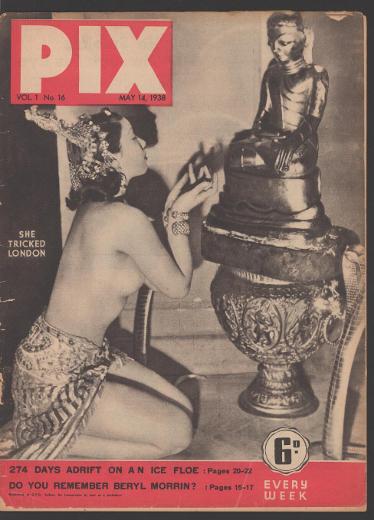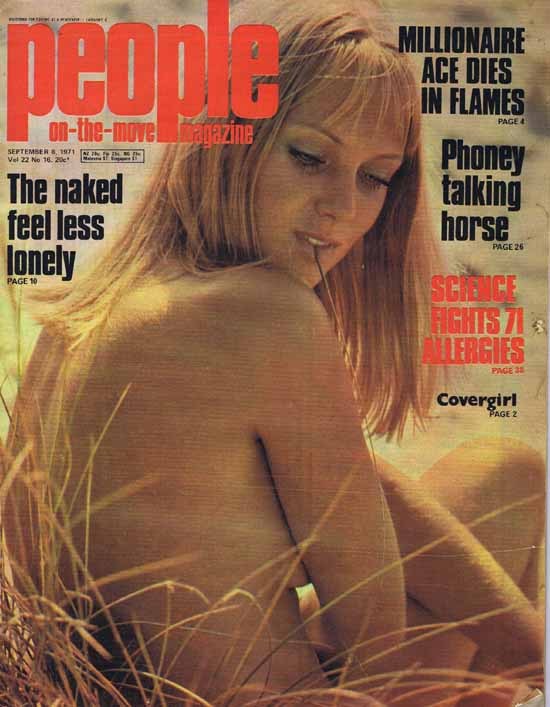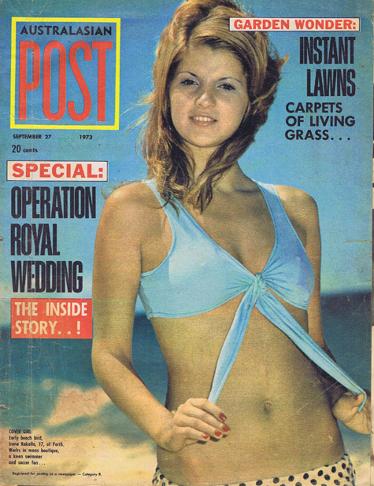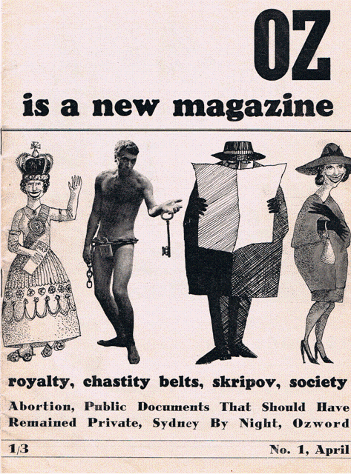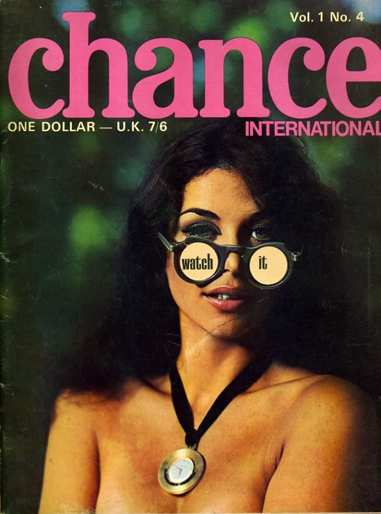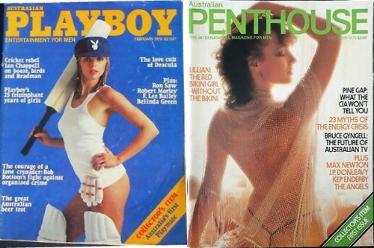Below is selection of Australian newspapers and magazines that
published stories and images around sex and sexuality that were deemed
too controversial for their time. Consequently, some of the Editors and contributors were censored, charged and even imprisoned.
Ever since the 1920s University publications have been a
part of campus life in Australia.
Magazines, journals, and newsletters served different purposes, whether promoting
the institution's achievements and the exchange of intellectual ideas,
collaborative efforts, and research, or serving the narrow interests of a
particular faculty.
By the 1960s Australian University students were being rapidly swept up in the counterculture that was taking place in the wider community, and student newspapers were becoming a highly effective, independent and balanced source of information.
For young university students, who were living through a radical time of change and discovery, being able to print what they deemed important was a direct challenge to the overwhelming sense of political conservatism that prevailed at the time; one which seemed to call for an almost stupefying obedience from its citizens.
"The constraints of censorship were applied beyond sexually explicit material, to horror, crime, cruelty, and violence, but politically radical views such as communism and blasphemy were also of concern in the 1960s." (Sally Percival)
In lieu of adequate sex education, student newspapers began to defy Australia's stringent censorship laws by publicly discussing sexually explicit topics.
In 1966 Farrago (Melbourne University) published an article titled Sex and the Single Student: How Not to Be a Mummy, which contained detailed advice on birth control. An article in the same issue advised new students that “if you value your virginity too much you may never lose it.”
In 1968 Honi Soit (University of Sydney), contained a four page spread entitled The Intelligent Woman’s Guide to Sex, while in 1970 Tharunka, (University of NSW) borrowing similar language, published Which Pill, The Intelligent Woman’s Guide. In 1971 they followed this up with the one off magazine Sex that provided information on virginity, masturbation, contraception, and venereal disease.
However, despite their defiance and challenges to censorship, University publications were still bound to abide by the same censorship laws that all published literature was regulated by. Consequently in 1970, several people associated with Tharunka found themselves charged with obscenity, having published an issue containing the poem Cunt is a Christian Word.
Outside of court on the day of the hearing, the Editor herself was arrested for wearing a nun's habit bearing a line suggested by the poem in question - 'I Have Been Fucked By God's Steel Prick'. She was charged for 'wearing an obscene publication' and was remanded on $100 bail to appear in court the following week. By 1971 Tharunka were facing eleven charges of obscenity with over forty obscenity cases being clocked up. As a result its Editor, Wendy Bacon, was found guilty of obscenity for her Nun’s habit stunt and consequently spent eight days in a women’s prison.
In 1972 The Little Red Schoolbook was published. It was a booklet for school children that contained information on drugs, sex, and authority within the school. It was legal in Australia, but priced at $1.75. Tharunka first distributed the book in tabloid form for free. In response the state designated the book a ‘restricted publication’ only to be sold through bookstores. In defiance of the law Tharunka produced a further 15000 copies and distributed them around schools.
"Censorship was not just about obscenity though. It was about freedom of speech in the contest of political and religious ideas." (Sally Percival)
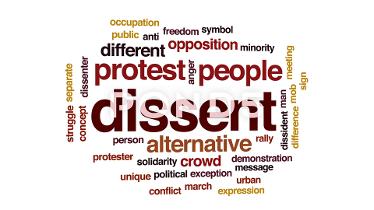
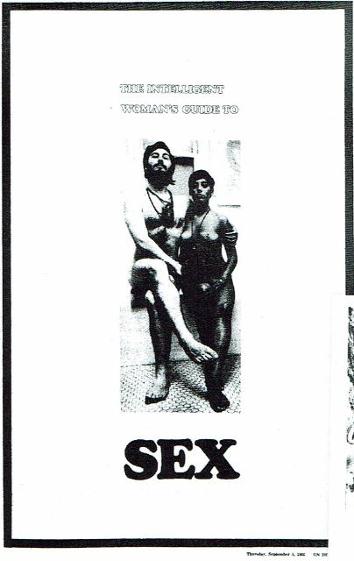
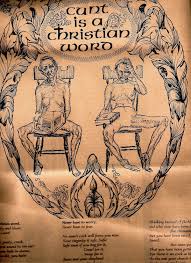
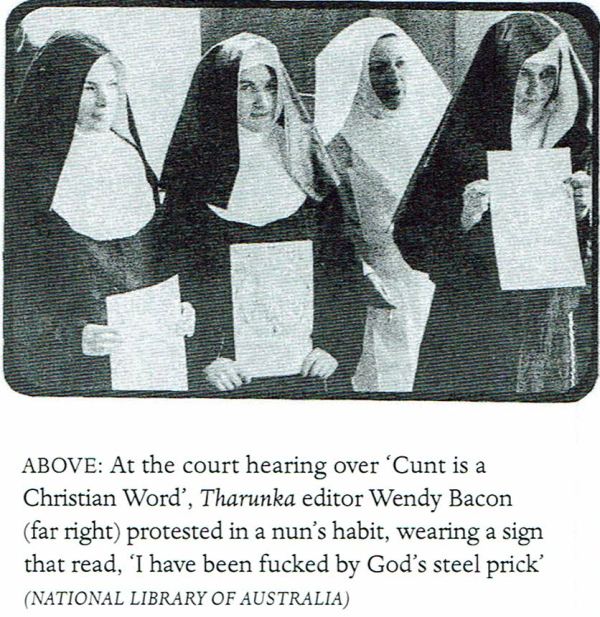
Tabloid periodicals like Pix, People and The Australasian Post began to emerge in Australia from the late 1930s onward. Similar in both format and content, these tabloids appeared as standard reading matter in barber shops across the country, and at the height of their popularity in the 1960s and 1970s, were read by millions of people.
In fact, so similar in content were Pix and People magazines that the two titles actually merged in 1972.
These magazines were most notable for their focus on Australian lifestyle and popular culture, as well as their irreverent content and the inclusion of pin-up style photographs of Australian women.
The first edition of Pix Magazine was published in January 1938 and was known for its focus on Australian lifestyle and popular culture, and for the inclusion of pin-up style photographs of Australian women.
The editors of the magazine regularly held pin-up girl competitions, and encouraged local women to submit photographs of themselves wearing swimwear for a chance to win prizes. In addition to providing a distraction for Australian servicemen during the Second World War, Pix magazine pin-up is thought to have played a role in the construction of the ideal of the Australian "beach girl" as a representation of Australian womanhood.
Pix favoured more
liberalised attitudes towards sex in its articles and, following in the wake of
the late 60s and 70s sexual revolution, became even more daring with its covers
and content – often running stories focused on adultery, hedonism and nudity.
Pix also provided many
local professional and amateur photographers with an additional source of
income by offering top rates for "unusual pictures which have not appeared
elsewhere".
View more copies of Pix Magazine HERE
People Magazine
People Magazine was a fortnightly magazine that began in 1950 and focused on celebrity interviews and scandal, glamour photography, sex stories sent in by readers, puzzles, crosswords, as well as a jokes page. The publisher was Bauer Media Pty Ltd and the magazine merged with weekly men's magazine Pix in 1972.
People was reportedly the first weekly magazine in Australia to feature topless models.
People magazine started a "Covergirl of the Year" quest in the early 1980s with Samantha Fox an early winner.
At its peak in the mid-1980s, People sold about 250,000 copies a week and was the fourth biggest-selling weekly magazine in Australia.
The Australasian Post
The Australasian Post, commonly called the Aussie Post, had its origins in The Australasian - a weekly picture magazine that started in 1857 – and was renamed the Australasian Post in 1946. The magazine featured a uniquely Australian basic format mix of scandal, sensationalism, human interest stories, fashion, politics, culture and entertainment.
The magazine, produced on cheap quality paper, focused heavily on Australiana in a basic easy to read format with large photos and pages of jokes and cartoons, including the Ettamogah Pub series by cartoonist Ken Maynard and the famous 'Crossword Puzzle'.
In the late 60s the Australasian Post began to regularly feature Bikini
cover girls, usually wholesome girls next door who were not professional
models.
In the late 70s the covers became more risque to reflect the times and
fashions that included crocheted bikinis, lace up shorts and sexy tops. The Bikini cover girl and titilation articles helped the
circulation rise to an all time high in the late 70s and early 80s. The
Australasian Post was renamed Aussie Post in 1997.
View more copies of People and the Australasian Post HERE
Oz (magazine) was an independently-published, alternative/underground magazine associated with the international counterculture of the 1960s. While it was first published in Sydney in 1963, a parallel version of Oz was published in London from 1967. The Australian magazine was published until 1969 and the British version until 1973.
The central editor, throughout the magazine's life in both countries, was Richard Neville. Co-editors of the Sydney version were Richard Walsh and Martin Sharp. Co-editors of the London version were Jim Anderson and, later, Felix Dennis, and then Roger Hutchinson.
In both Australia and the UK, the creators of Oz were prosecuted on charges of obscenity. A 1963 charge was dealt with expeditiously when, upon the advice of a solicitor, the three editors pleaded guilty.
In two later trials, one in Australia in 1964 and the other in the United Kingdom in 1971, the magazine's editors were acquitted on appeal, after initially being found guilty and sentenced to harsh jail terms.
View all Issues of Oz Magazine HERE
The early 1960s saw a sudden influx of ‘under the counter’ men’s newspapers with names such as Obscenity, Searchlight, Sexy, and Ribald; with the most memorable of these possibly being the Kings Cross Whisper.
The Kings Cross Whisper (sometimes spelled King's Cross) was a ‘gags, tits and bums rag’ that was famed for its naughty nudes and its hilarious, boisterous, tongue-in-cheek satire on the issues and the important people of the day.
'The Whisper' was started up as a bit of a fun by two local Kings Cross journalists in 1964. It was first sold to New Year's revellers in Kings Cross and then over the years sold on the streets of Kings Cross for just 20 cents an issue. It lasted well into the 1970s and even made a bit of money for its writers.
At a time when page 3 girls were banned in regular
Australian newspapers, The Kings Cross Whisper aimed to shock the
wowsers and other respectable citizens, and it certainly succeeded in doing
that. It was forever at war with the authorities, and the NSW government
and police (not to mention the governments of
Apart from the humour, browsing through the issues of Kings Cross Whisper gives us a glimpse of the 60s/70s rebellion against the conservative values of Australian society and against the conservative Liberal/National governments of the day.
"I think it was our sheer cheek that took them by surprise. How dare we? I was wild and wonderful. For a brief and glorious moment we actually made a quid making people laugh." (Terry Blake)
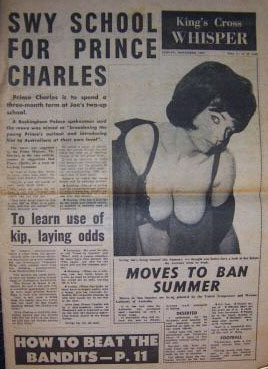
Remembering the Kings Cross Whisper.mp3
The increasing influx of what might now be described as ‘soft porn’ magazines and newspapers during the 1960s eventually led to various amendments of the Obscene and Indecent Publications Act (1901), in 1967. These included the establishment of a State Advisory Committee (to review publications and make recommendations to the government) and the creation of a new category of restricted publications that could be sold in shops but out of view to the public. All of which opened the way for more openly erotic magazines to hit the market.
In 1966, Gareth Powell, in association with Jack de Lissa, founded another monthly magazine, Chance. Inspired by American Playboy and Penthouse, Chance introduced more beautiful unclad Australian women. It also caused a landmark court case after an issue, arriving from Hong Kong where it was printed, was seized by customs in 1968 on the grounds that it was obscene and had not been reviewed as it was printed overseas. The case was settled in the magazine’s favour. Powell sold Chance in the early 1970s and it eventually disappeared from the market.
Australian Playboy and Penthouse
Both Australian Playboy and
Australian Penthouse appeared on newsagent stands in 1979. Playboy’s first
print-run of 300,000 sold out quickly. Similar to the American edition (first
published in 1953 by Hugh Hefner), it also featured nudity and sought-after
centerfolds, as well as in-depth interviews, full page cartoons, feature
articles, reviews and an annual 'Playmate of the Year'.
While sales remained stable through the 1980s, by the 1990s they began to fall dramatically, probably due to easier access to other forms of pornography and competition from new magazines.
- Background Images - Oz Magazine, Issue 31, 1966 - Source: University of Wollongong and Tharunka Newspaper, 1955 - Source required
- The Intelligent Woman’s Guide to Sex, 1968 - Source: Dissent - The Student Press in 1960s Australia
- Cunt is a Christian Word poem, Tharunka, 1970 - Source: Wendy Bacon
- Tharunka court hearing, 1970 - Source: Dissent - The Student Press in 1960s Australia
- Pix Magazine, 1938 - Source: Trove
- People Magazine, 1971 - Source: Moviemem
- People Magazine Article, 1989 - Source Sydney Morning Herald
- Australasian Post, 1973 - Source: Moviemem
- Oz Magazine, Issue 1, 1963 - Source: University of Wollongong
- Kings Cross Whisper, 1965 - Source: Kings Cross Whisper
- Chance International, vol. 1, no. 4 - Source: Gareth Powell Books and Magazines
- Playboy and Penthouse Magazines, 1979 - Source: Ebay
- Wood, Sally Percival. (2017). Dissent : the Student Press in 1960s Australia, Scribe Publications, Brunswick, Victoria
- Blatt, S. (2000). Censorship in Australia (Essay). Monash University Melbourne.
- Sally Percival - Source: Dissent
- Terry Blake - Source: Kings Cross Whisper
- David Naylor - Source: Revolvy
- Remembering the Kings Cross Whisper - Source: ABC
- Lifestyle - Collecting Men's Magazines
- Chance International
- Gareth Powell Books and Magazines
- Australian Playboy
- Australian Penthouse
- The Sedition Festival - Protest art from Sydney in the 1970s
- People Magazine
- People Magazine - Good Weekend Article
- People Magazine - Guardian Article
- Pix Magazine
- Pix Magazine - State Library NSW
- Pix Magazine - Trove
- List of Men's Magazines

|
Alternative Press.pdf Size : 793.518 Kb Type : pdf |
